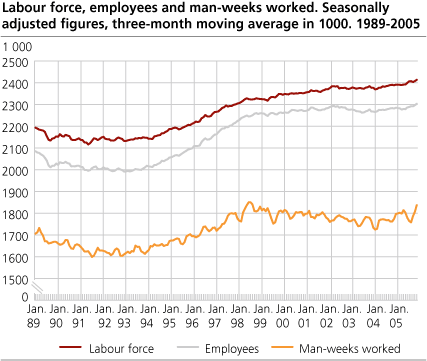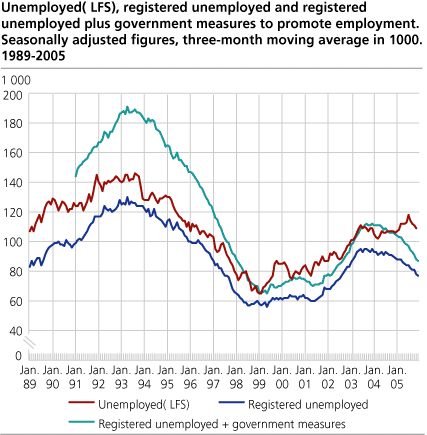Content
Published:
This is an archived release.
More people working full time
The number of employees working full time increased by 47 000 from Q4 2004 to Q4 2005, while the number of part time workers went down by 21 000. The figures are taken from the latest Labour Force Survey (LFS) carried out by Statistics Norway.
|
Seasonally adjusted figures: Rising employment
The number of employees rose, while unemployment went down, from the third to the fourth quarter of 2005, according to seasonally adjusted figures from the LFS. The increase in employment was inside the LFS error margin, but is consistent with the upward trend we have seen since the summer of 2003. The decline in unemployment was approximately on level with the error margin. The seasonal adjustment method is a favourable method of revealing the current development in the labour market, and serves as an alternative to comparisons with the corresponding quarter in the previous year. Seasonally adjusted figures are presented in a separate article . |
Both men and women experienced an increase in full time employment. In total, employment went up by 24 000 people from the fourth quarter 2004. The industry with the strongest increase was financial intermediation and business activities. Detailed employment figures by occupation for 2005 are presented in a separate article .
24 000 fewer temporary employed
The number of temporary employees was 187 000 in the fourth quarter of 2005, a fall of 24 000 from the fourth quarter of 2004. Temporary employment was most common in education, health and social work, as well as in hotels and restaurants. At the opposite end of the scale, manufacturing, in addition to transport and communication are characterised by relatively few temporary employees.
Unchanged labour force participation
Total labour force participation stayed unchanged at 72.3 per cent from the fourth quarter of 2004 to the fourth quarter of 2005. The 2005 annual average figures show that the gap between male and female labour force participation is at its smallest ever (7.5 percentage points).
98 000 people unemployed
The number of unemployed people in the fourth quarter of 2005 was 98 000, approximately unchanged from the fourth quarter of 2004. The total unemployment rate was 4.1 per cent, the rate for men 4.3 per cent and the rate for women 3.9 per cent. In the same period, the proportion of long-term unemployed stayed unchanged at 26 per cent. Long-term unemployment is defined as unemployment that has lasted for at least six consecutive months.
95 000 underemployed
The number of underemployed, i.e. part-time employees who want to work more hours, was 95 000 in the fourth quarter of 2005, approximately unchanged from the fourth quarter of 2004.
The underemployed represent 15.9 per cent of all part-time employees, compared with 15.6 per cent in the fourth quarter of 2004. The majority of the underemployed work in health and social work or retail trade. Half of all part-time employees work in these two sectors.
Actual hours worked for the unemployed and underemployed amounted to 116 000 man-weeks (full-time work) in the fourth quarter of 2005 - 4 000 less than in the fourth quarter 2004.
EU unemployment down
The seasonally adjusted unemployment rate for Norway was 4.5 per cent in November, compared with 4.8 per cent in August. OECD and Eurostat figures for most countries are only available for October. Compared with July, the rate in the EU15 area fell from 7.8 to 7.6 per cent, and in the OECD area from 6.5 to 6.4 per cent. In the same period, the unemployment rate stayed unchanged at 5.0 per cent in the USA. From July to October, the unemployment rate fell from 8.2 to 8.1 per cent in Finland, from 9.3 to 9.1 per cent in Germany, and from 9.5 to 9.3 per cent in France.
Tables:
- Table 1. Population aged 16-74 in the labour force, man-weeks worked, registered unemployed persons and persons employed by government measures. 1000 and per cent
- Table 2. Population aged 16-74 år in the labour force, employed persons and unemployed persons by sex (LFS). 1000 and per cent
- Table 3. Persons in the labour force and employed persons by age and sex (LFS). 1 000 and per cent
- Table 4. Population aged 16-74, employed persons by settled/usual working hours per week and unemployed persons by age and sex (LFS). 1000
- Table 5. Persons in the labour force by age and sex. 1000 and as per cent of all in each group
- Table 6. Employed persons by sex and settled/usual working hours pr week (LFS). 1 000
- Table 7. Population aged 16-74 by main activity, part-time employment and age (LFS). 1 000
- Table 8. Employed persons by major industry division. 1000
- Table 9. Number of man-hours worked per week, by industry division (LFS). 1 000
- Table 10. Employed persons,total, and employed persons at work by status and sex. Number of man-weeks worked1 and actual working hours per week (LFS)
- Table 11. Employed persons and absence from work during the whole survey week by reason for absence and sex(1). 1000 and per cent
- Table 12. Employees with temporary jobs, by major industry division (LFS). 1000 and as per cent of all employees
- Table 13. Unemployed persons by sex and age (LFS). 1000 and per cent
- Table 14. Unemployed persons by duration of job search (LFS). 1000 and per cent
- Table 15. Unemployed persons by main activity (LFS). 1 000
- Table 16. Unemployed and underemployed persons, by sex and desired working hours per week. Number of man-weeks (of 37,5 hours) supplied (LFS). 1000
- Table 17. Employment and unemployment for persons aged 16-74 years, seasonally adjusted, three-months moving average. Absolute figures in 1000 and unemployed persons in per cent of the labour force.
- Table 18. Persons in the labour force by sex and region (LFS). 1 000 and in per cent of total. 16-74 years
- Table 19. Employed persons by sex and region (LFS). 16-74 years. 1 000
- Table 20. Employed persons by sex and regions (LFS) as per cent of all inn each group. 16-74 years
- Table 21 Employed persons, by some major industry division and region (LFS). 1997-2005. 1 000
Contact
-
Arbeidsmarked og lønn
E-mail: arbeidsmarked@ssb.no
-
Erik Herstad Horgen
E-mail: erik.horgen@ssb.no
tel.: (+47) 93 08 68 62
-
Håvard Hungnes Lien
E-mail: havard.lien@ssb.no
tel.: (+47) 40 90 26 06


